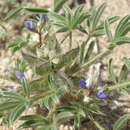en
names in breadcrumbs


Lupinus pusillus, the rusty lupine[1] or dwarf lupine, is an annual plant in the legume family (fabaceae) found in the Colorado Plateau and Canyonlands region of the southwestern United States(California),[2]: 159 and north to Montana.
It is an annual plant growing up to 9 inches (23 cm) tall. "Pusillus is for the small size of the plant.[2]: 159
Leaves are compound palmate with 3-9 1⁄2 to 1+1⁄2 inches (1.3 to 3.8 cm) long inversely lance- shaped leaflets.[2]: 159
Plant stems and leaf stems (petioles) have long spreading hairs.[2]: 159
It blooms from April to June.[2]: 159
Flowers are in stalks of 4-38 and bluish to purple or bicolored, with a yellow spot on the upper petal.[2]: 159
Seedpods are nearly oval and have constrictions separating the seeds.[2]: 159
It can be found in desert shrubland and pinyon juniper woodland communities, from as far north as Washington, to California, and throughout the southwest.[2]: 159
When growing in reddish sand, the blue flowers make a striking contrast with the sun at a low angle.[2]: 159
It is pollinated by bees.[2]: 159
 Lupinus pusillus in the Wyoming big sagebrush steppe biome, near Phillips, Montana.
Lupinus pusillus in the Wyoming big sagebrush steppe biome, near Phillips, Montana. Lupinus pusillus, the rusty lupine or dwarf lupine, is an annual plant in the legume family (fabaceae) found in the Colorado Plateau and Canyonlands region of the southwestern United States(California),: 159 and north to Montana.